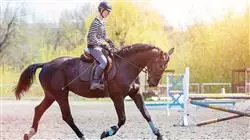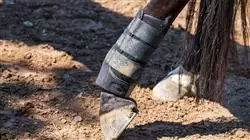University certificate
The world's largest faculty of physiotherapy”
Introduction to the Program
Equine Rehabilitation and Physiotherapy is a growing discipline that requires trained professionals to care for horses"

One of the main pillars of this Postgraduate diploma is the exhaustive and meticulous knowledge of the horse's anatomy, both from the functional point of view as well as its biomechanical behavior. The movement of the horse is developed fundamentally in three gaits: walk, trot and canter. However, as in humans, each equestrian discipline requires specific biomechanics and therefore has specific locomotor requirements. Knowing this dynamic will allow for getting the best physical performance out of the horse.
Likewise, achieving the maximum sporting performance of an athletic horse depends to a large extent on proper training planning. With proper and individualized planning, in addition to achieving the performance appropriate to the genetic potential of the horse, the risk of fatigue, exhaustion and, therefore, musculoskeletal injuries and overtraining will be reduced.
This Postgraduate diploma provides students with specialized tools and skills to successfully develop their professional activity, working on key competencies such as knowledge of the reality and daily practice of the professional, and developing responsibility in the monitoring and supervision of their work, as well as communication skills within the essential teamwork.
In addition, as it is an online Postgraduate diploma, the student is not conditioned by fixed schedules or the need to move to another physical location, but can access the contents at any time of the day, balancing their work or personal life with their academic life.
Don't miss the opportunity to study with us in this Postgraduate diploma in Horse Functional Anatomy, Biomechanics and Training. It's the perfect opportunity to advance in your career"
This Postgraduate diploma in Horse Functional Anatomy, Biomechanics and Training contains the most complete and up-to-date educational program on the market. The most important features include:
- Practical cases presented by experts in equine physiotherapy and rehabilitation
- The graphic, schematic, and practical contents with which they are created, provide scientific and practical information on the disciplines that are essential for professional development
- The latest news on horse biomechanics and training
- Practical exercises where self-assessment can be used to improve learning
- Special emphasis on innovative methodologies in biomechanics and training in horses
- Theoretical lessons, questions to the expert, debate forums on controversial topics, and individual reflection assignments
- Content that is accessible from any fixed or portable device with an Internet connection
This Postgraduate diploma is the best investment you can make in selecting a refresher program to update your knowledge in Horse Functional Anatomy, Biomechanics and Training”
Its teaching staff includes professionals from the field of physiotherapy, who contribute their work experience to this program, as well as renowned specialists from leading societies and prestigious universities.
The multimedia content, developed with the latest educational technology, will provide the professional with situated and contextual learning, i.e., a simulated environment that will provide immersive training programmed to train in real situations.
This program is designed around Problem-Based Learning, whereby the professional must try to solve the different professional practice situations that arise throughout the program. For this purpose, the professional will be assisted by an innovative interactive video system created by renowned and experienced experts in horse functional anatomy, biomechanics and training.
This program comes with the best educational material, providing you with a contextual approach that will facilitate your learning"

This 100% online Postgraduate diploma will allow you to combine your studies with your professional work while increasing your knowledge in this field"
Why study at TECH?
TECH is the world’s largest online university. With an impressive catalog of more than 14,000 university programs available in 11 languages, it is positioned as a leader in employability, with a 99% job placement rate. In addition, it relies on an enormous faculty of more than 6,000 professors of the highest international renown.

Study at the world's largest online university and guarantee your professional success. The future starts at TECH”
The world’s best online university according to FORBES
The prestigious Forbes magazine, specialized in business and finance, has highlighted TECH as “the world's best online university” This is what they have recently stated in an article in their digital edition in which they echo the success story of this institution, “thanks to the academic offer it provides, the selection of its teaching staff, and an innovative learning method aimed at educating the professionals of the future”
A revolutionary study method, a cutting-edge faculty and a practical focus: the key to TECH's success.
The most complete study plans on the university scene
TECH offers the most complete study plans on the university scene, with syllabuses that cover fundamental concepts and, at the same time, the main scientific advances in their specific scientific areas. In addition, these programs are continuously being updated to guarantee students the academic vanguard and the most in-demand professional skills. In this way, the university's qualifications provide its graduates with a significant advantage to propel their careers to success.
TECH offers the most comprehensive and intensive study plans on the current university scene.
A world-class teaching staff
TECH's teaching staff is made up of more than 6,000 professors with the highest international recognition. Professors, researchers and top executives of multinational companies, including Isaiah Covington, performance coach of the Boston Celtics; Magda Romanska, principal investigator at Harvard MetaLAB; Ignacio Wistumba, chairman of the department of translational molecular pathology at MD Anderson Cancer Center; and D.W. Pine, creative director of TIME magazine, among others.
Internationally renowned experts, specialized in different branches of Health, Technology, Communication and Business, form part of the TECH faculty.
A unique learning method
TECH is the first university to use Relearning in all its programs. It is the best online learning methodology, accredited with international teaching quality certifications, provided by prestigious educational agencies. In addition, this disruptive educational model is complemented with the “Case Method”, thereby setting up a unique online teaching strategy. Innovative teaching resources are also implemented, including detailed videos, infographics and interactive summaries.
TECH combines Relearning and the Case Method in all its university programs to guarantee excellent theoretical and practical learning, studying whenever and wherever you want.
The world's largest online university
TECH is the world’s largest online university. We are the largest educational institution, with the best and widest online educational catalog, one hundred percent online and covering the vast majority of areas of knowledge. We offer a large selection of our own degrees and accredited online undergraduate and postgraduate degrees. In total, more than 14,000 university degrees, in eleven different languages, make us the largest educational largest in the world.
TECH has the world's most extensive catalog of academic and official programs, available in more than 11 languages.
Google Premier Partner
The American technology giant has awarded TECH the Google Google Premier Partner badge. This award, which is only available to 3% of the world's companies, highlights the efficient, flexible and tailored experience that this university provides to students. The recognition as a Google Premier Partner not only accredits the maximum rigor, performance and investment in TECH's digital infrastructures, but also places this university as one of the world's leading technology companies.
Google has positioned TECH in the top 3% of the world's most important technology companies by awarding it its Google Premier Partner badge.
The official online university of the NBA
TECH is the official online university of the NBA. Thanks to our agreement with the biggest league in basketball, we offer our students exclusive university programs, as well as a wide variety of educational resources focused on the business of the league and other areas of the sports industry. Each program is made up of a uniquely designed syllabus and features exceptional guest hosts: professionals with a distinguished sports background who will offer their expertise on the most relevant topics.
TECH has been selected by the NBA, the world's top basketball league, as its official online university.
The top-rated university by its students
Students have positioned TECH as the world's top-rated university on the main review websites, with a highest rating of 4.9 out of 5, obtained from more than 1,000 reviews. These results consolidate TECH as the benchmark university institution at an international level, reflecting the excellence and positive impact of its educational model.” reflecting the excellence and positive impact of its educational model.”
TECH is the world’s top-rated university by its students.
Leaders in employability
TECH has managed to become the leading university in employability. 99% of its students obtain jobs in the academic field they have studied, within one year of completing any of the university's programs. A similar number achieve immediate career enhancement. All this thanks to a study methodology that bases its effectiveness on the acquisition of practical skills, which are absolutely necessary for professional development.
99% of TECH graduates find a job within a year of completing their studies.
Postgraduate Diploma in Functional Anatomy, Biomechanics and Training in Horses
If you are a professional in the field of equine physiotherapy, or if you want to specialize in this area, TECH offers you the opportunity to take the Postgraduate Diploma in Functional Anatomy, Biomechanics and Training in the Horse, an online program designed to train experts in the field and provide essential tools and knowledge for the correct evaluation and treatment of pathologies of the locomotor system in equines. This program, taught by recognized specialists in equine physiotherapy, is presented as a quality, flexible and accessible online training option that will allow you to combine your studies with your work and personal commitments. In addition, thanks to the use of the most innovative technologies, you will be able to access the Postgraduate Certificate content from anywhere and at any time. Among the benefits of studying at TECH, we highlight the possibility of learning in an interactive way and with a practical approach, based on real cases and with the support of advanced didactic resources. In addition, you will have access to an online platform that will allow you to be in permanent contact with your fellow students and specialized tutors, which will foster your collaborative learning and provide you with constant support throughout the training process.
Specialization in physiotherapy for horses
The curriculum will cover key topics such as the anatomy and physiology of the horse's locomotor system, biomechanics of movement and the most common pathologies, as well as equine training and re-education. All this, with a focus on the application of specific therapeutic techniques, such as osteopathy, acupuncture, electrotherapy, among others. If you want to specialize in equine physiotherapy, this Postgraduate Diploma is the answer. You will be able to acquire the knowledge and tools necessary to evaluate and treat pathologies of the equine locomotor system, all from a practical and interactive perspective, with the constant support of specialized tutors and the flexibility you need to combine your studies with your work and personal responsibilities. Enroll now and become an expert in equine physiotherapy!







